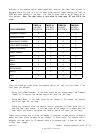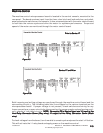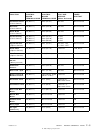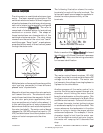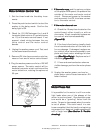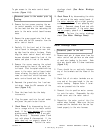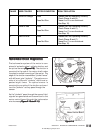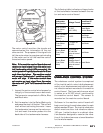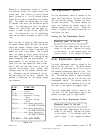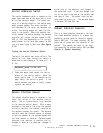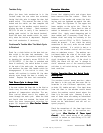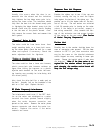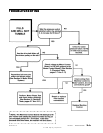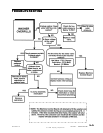
© 1998 Maytag Corporation
16008373-01 SECTION 2. ELECTRICAL COMPONENTS & TESTING
2-12
RPM FUNCTION
47 ...........................Tumble
47-85 .......................Distribution
90-250.....................Accelerate Through
Critical
250-499..................Accelerate Through
Critical
500-575..................High Speed Acceleration
- WILL DROP TO 450 RPM
600-675..................High Speed Acceleration
- WILL DROP TO 555 RPM
>675.......................High Speed Acceleration
- WILL DROP TO 650 RPM
750-800.............TOP SPIN SPEED
Figure 2-12
Strut Displacement Switch
The strut displacement switch is clipped to the
top of the left rear strut. The switch senses
the outer tub bottoming out on the strut as
the machine accelerates above 90 rpm. This
is caused by the twisting motion of the outer
tub. This additional switch is required because
the twisting motion may not trip the outer tub
displacement switch. The primary cause for
activation would be an unbalance at the front
and rear of the spinner on opposite sides.
The strut displacement switch is wired in se-
ries with the tub displacement switch and
causes the same type of redistribution.
Testing the Strut Displacement Switch:
1. Disconnect power to the unit.
2. Place ohm meter leads across the two ter-
minals of the switch. Depress the button
on the switch. If the contacts close, the
switch is good. If not, replace the switch.
Tub Displacement Switch
The tub displacement switch is located on the
upper right hand side of the outer tub, below
the top concrete weight, between the outer
tub and the cabinet. The switch senses the
outer tub touching the cabinet side as the
machine passes through critical. When this
switch is tripped, the machine stops and re-
distributes the load.
Testing the Tub Displacement Switch:
1. Disconnect power to the unit.
2. Place ohm meter leads across the two ter-
minals of the switch. Depress the button
on the switch. If the contacts open, the
switch is good. If not, replace the switch.
Whenever a displacement switch is tripped,
the machine stops and redistributes the
clothes load. This involves a three (3) second
pause, followed by a five (5) second reverse
tumble (47-49 rpm) to redistribute the clothes
load. The washer will pause again for three
(3) seconds, then start the distribution profile
again. To redistribute the load, the machine
tumbles the load (50-90 rpm) and again at-
tempts to pass through critical (about 150
rpm). The machine will try to redistribute
twice as the washer attempts to spin at 800
rpm.
Once the load is properly redistributed and
the speed reaches above 500 rpm, the inertial
switch and cabinet vibration sensor are used.
If the inertial switch or sensor is activated, the
washer will drop in spin speed. This is based
upon the speed at which switch activation
takes place. See Figure 2-12 outlining the spin
speed categories and the corresponding re-
duced speeds. If the switches are not acti-
vated, the final spin speed will reach a maxi-
mum of 850 rpm and then drop to find the
optimum performance level, based upon
readings taken by the cabinet vibration sen-
sor. Consumers may be confused by the up-
and-down cycling of the motor. However, the
machine is searching for the optimal speed
performance.



